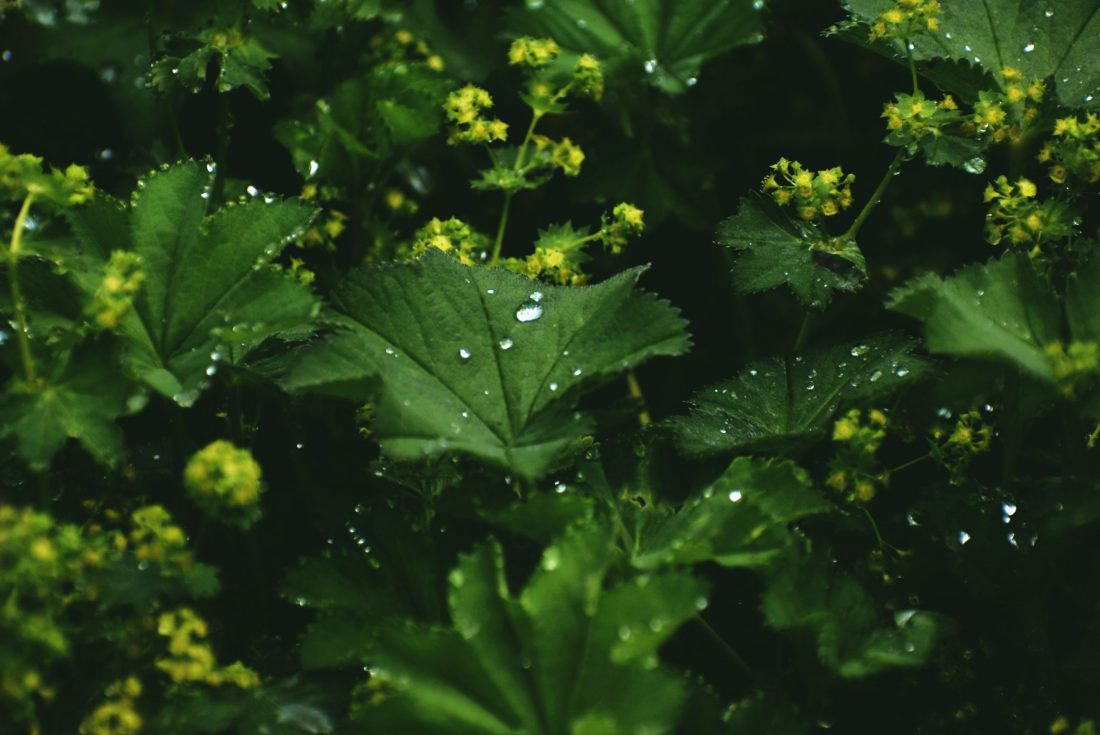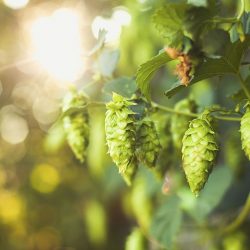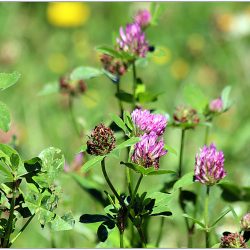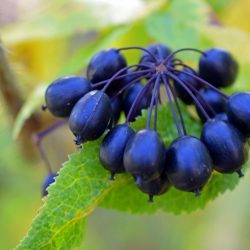Petite, vivace et rustique, l’alchémille ne peut prétendre à la sensualité et la luxuriance de certaines autres plantes. Cependant, elle se distingue par sa capacité à recueillir la rosée dans ses feuilles. Cette eau, plus qu’une simple rosée, est également une eau végétale excrétée par la plante elle-même, nommée « eau céleste ». En raison de sa pureté parfaite, cette eau était dite être utilisée par des alchimistes dans leur quête de la pierre philosophale.
Qu’est ce que l’Alchémille ?
L’Alchémille commune ou Pied-de-lion (Alchemilla vulgaris L.; Alchemilla Mollis) appartient à la famille des Rosacées. Cette plante herbacée couvre-sol se développe bien sur les sols humides et dans les lieux ombragés. Ses feuilles rondes, en forme d’accordéon, retiennent des gouttes de rosée, ce qui attire l’attention.
Synonymes incluent Alchemilla acutiloba Opiz et Alchemilla acutangula Buser. On la connaît aussi sous les noms communs de manteau de notre Dame, patte de lapin, pied de griffon, porte-rosée, herbe aux femmes.
L’alchémille commune, originaire d’Europe, pousse principalement en montagne en France. Elle mesure de 10 cm à 90 cm de haut. Ses rhizomes légèrement ligneux supportent des tiges grises vertes et duveteuses. Les feuilles, dentelées et palmatifides, comportent de neuf à onze lobes.
Les fleurs, en corymbes jaunes de 5mm, fleurissent de mai à octobre. La tige florale se développe en ramification sympodiale pleiochasiale. Le fruit à coque de l’alchémille porte une seule graine et est donc monosédique.
Cette plante se caractérise par des tiges élancées pouvant atteindre 60 cm de haut. Ses feuilles vert-gris sont dentées, arrondies, et possèdent 7 à 11 lobes peu profonds. Les feuilles excrètent des gouttes d’eau sous haute humidité.
Ses fleurs vert-jaune, minuscules et nombreuses, composent un calice de 5 sépales et un seul carpelle. Elles sont regroupées en cyme au sommet des tiges. L’alchémille produit un akène, un fruit sec contenant une graine.
La drogue se compose des parties aériennes fleuries séchées, entières ou fragmentées. L’alchémille contient au minimum 6% de tanins hydrolysables, avec l’agrimoniine, la pédunculagine, et la laevigatine F comme principaux tanins. On trouve aussi environ 2% de flavonoïdes, sous forme de glucuronyl-3 quercétol et de quercétol libre. L’acide ellagique est le principal acide polyphénol, présent à hauteur de 0,3 à 0,4%, accompagné de l’acide chlorogénique.
Un peu d’histoire
L’engouement de Paracelse pour l’alchémille a grandement contribué à son prestige durant la Renaissance. Le médecin espagnol Andrés Laguna de Segovia (1499-1559), actif au début de cette période florissante, recommandait l’alchémille pour des affections spécifiques. Il préconisait de réduire sa racine en poudre, puis de la mélanger à du vin rouge. Ce mélange constituait un remède efficace contre les blessures internes et externes. Ce choix s’avérait judicieux, vu l’astringence de cette plante riche en tanins.
Toutefois, l’alchémille n’est pas une plante de la Lune pour rien… En effet, il existe un élixir floral d’alchémille destiné aux femmes qui renient l’aspect maternel ou nourricier de leur féminité. Cette plante aide à surmonter les sensations de perte ou de vacuité liées aux troubles de la sphère gynécologique, en particulier dans son aspect reproductif. Elle agit également sur le chakra du cœur, souvent affecté par diverses expériences psycho-émotionnelles. Ces perturbations peuvent entraîner de l’indifférence et une incapacité à aimer ou à exprimer son amour, par crainte du rejet et de l’échec.
Ce chakra est aussi affecté par les déceptions amoureuses fréquentes, les relations amicales qui se dérobent, le manque de générosité, l’égoïsme, le repli sur soi, le sentiment de solitude, etc. Sur tout cela, l’élixir floral d’alchémille peut donc avoir une incidence marquée, préférablement en synergie avec d’autres élixirs floraux comme ceux de jasmin, d’aubépine, de violette des bois et d’une autre violette, celle dite aquatique, et qui n’est pas autre chose que le Water violet du docteur Edward Bach.
Quelles sont les principales propriétés pharmacologiques des parties aérienne de l’Alchémille ?
L’Alchémille est une plante médicinale populaire mais quelles sont exactement ses propriétés pharmacologiques ? Dans cette section, nous allons explorer en détail les principales propriétés pharmacologiques des parties aériennes de l’alchémille et comment elle peut être utilisée pour améliorer votre santé et votre bien-être.
Propriétés gynécologiques
L’Alchémille est une plante médicinale couramment utilisée en phytothérapie pour traiter une variété de problèmes de santé, y compris les problèmes gynécologiques. In vitro, l’alchémille réduit les lésions d’endométriose et l’activité inflammatoire qui s’y rattache.
L’Alchémille régule la sécrétion ovarienne de progestérone et facilite la production lutéale. Cette action la rend efficace dans le traitement de l’endométriose et des troubles prémenstruels. Grâce à son activité de type progestatif et son action emménagogue, l’alchémille régularise les menstruations. On utilise principalement ses feuilles pour ces vertus.
Cette herbe, reconnue pour ses bienfaits liés à la menstruation et aux maux féminins, possède des propriétés astringentes et anti-inflammatoires. Elle réduit les pertes abondantes et prévient le prolapsus et les leucorrhées. L’alchémille agit comme un régulateur hormonal en stimulant l’hypophyse dans le cerveau, le centre de contrôle des hormones. Durant la ménopause, elle apaise les insomnies.
L’alchémille est une plante lutéotrope, stimulant la sécrétion de progestérone par les ovaires. Elle augmente ainsi les taux de LH dans l’organisme. De plus, elle influe sur la synthèse des androgènes en inhibant la 5-α-réductase. Cela bloque la synthèse de la dihydrotestostérone (DHT). En conséquence, la transformation de la testostérone en estradiol est favorisée.
L’alchémille offre donc une double action hormonale : elle augmente les taux de progestérone et bloque la transformation de la testostérone en DHT, favorisant ainsi la formation des œstrogènes. Elle agit également contre les douleurs prémenstruelles liées à une hyperfolliculémie.
Propriétés anti-inflammatoires, cytoprotectrices et antalgiques
L’Alchémille possède des propriétés antispasmodiques et sédatives, ainsi qu’une action antimutagène due à ses tanins.
En tant qu’agent anti-inflammatoire et antioxydant, l’alchémille inhibe in vitro l’élastase, la trypsine et la chymotrypsine. Son extrait aqueux piège les anions superoxydes et inhibe la collagénase. En 2018, une étude a identifié un flavonoïde, la quercétine-3-O-β-glucoronide, dans Alchemilla vulgaris. Cette découverte, réalisée via une technique métabolomique basée sur la résonance magnétique nucléaire, a révélé que ce composé a une activité anti-collagénase plus élevée que d’autres flavonoïdes. Il surpasse même la doxycycline, le seul inhibiteur de la collagénase approuvé par la FDA (Federal Drug Administration).
Les propriétés anti-inflammatoires de l’alchémille découlent de l’inhibition de la production de NO et de cytokines pro-inflammatoires (lutéoline-7-O-glucoside). La plante a également démontré une activité antibactérienne contre Staphylococcus aureus et Salmonella enteritidis. Plusieurs études ont confirmé sa capacité à inhiber l’élastase, la trypsine et l’α-chymotrypsine. Ces enzymes jouent un rôle clé dans les phénomènes inflammatoires.
Propriétés vasculaires
Décongestionnante pelvienne, angioprotectrice et antihypertensive, in vivo, l’alchémille améliore la protection des tissus conjonctifs et élastiques. Du fait de ses flavonoïdes, elle améliore la circulation sanguine (jambes lourdes). Elle protège la structure et améliore la fonction (notamment la déformabilité) des membranes érythrocytaires au cours de l’hypertension artérielle expérimentale.
L’Alchémille, riche en tanins, possède des propriétés astringentes et hémostatiques, utiles notamment pour les règles abondantes ou hémorragiques. Cette plante offre aussi une activité anti-diarrhéique. Ex vivo, des tests sur l’endothélium d’artères mésentériques de rat ont démontré son action vasorelaxante et hypotensive. L’extrait méthanolique d’A. vulgaris s’est révélé plus efficace que l’extrait aqueux dans des conditions d’hypertension normales et expérimentales. Cela confirme son usage traditionnel dans les troubles cardiovasculaires, en particulier l’hypertension.
Une étude de 2015 a révélé que l’extrait aqueux ou alcoolique d’alchémille possède des propriétés vasoactives et antihypertensives. In vitro, ces extraits ont induit une relaxation concentration-dépendante des artères de rat. L’extrait hydro-alcoolique a causé une relaxation en présence de prostaglandine 2α et une contraction avec le potassium. Ces différences seraient dues à une variation de composition entre les extraits, notamment en flavonoïdes et acide gallique.
Les flavonoïdes ont une activité vasorelaxante diminuée en présence d’une forte concentration de potassium. L’acide gallique dans l’extrait aqueux serait plus actif que les flavonoïdes dans ces conditions. Les deux extraits n’ont montré aucune modification d’activité en absence d’endothélium ou en présence d’inhibiteurs spécifiques, indiquant que l’activité de l’alchémille sur les vaisseaux n’est pas régulée par l’endothélium ou les vasodilatateurs qu’il sécrète.
In vivo, l’administration quotidienne de l’extrait hydro-alcoolique d’alchémille à des rats traités avec un inhibiteur de NO-synthase a réduit l’hypertension. Cela suggère une protection cardiovasculaire potentielle de l’alchémille.
Enfin, une étude de 2006 a montré qu’un extrait sec d’alchémille administré à des rats modifie les globules rouges, réduisant les érythrocytes anormaux et augmentant les lipides et phospholipides membranaires. Cela améliore la déformabilité des globules rouges, facilitant potentiellement le flux sanguin et réduisant la viscosité du sang, bénéfique en cas d’hypertension ou de pathologies cardiaques ou veineuses.
Propriétés anti-infectieuses et cicatrisantes
L’Alchémille, connue pour ses propriétés antifongiques (anti Candida albicans) et antimicrobiennes, tire ses qualités anti-infectieuses de sa richesse en tanins. Ses catéchines ont montré une activité antivirale in vitro contre les virus de la vaccine et de l’ectromélie, dépendante de la dose.
En plus de stimuler in vitro la multiplication des cellules épithéliales et des myofibroblastes aortiques, l’alchémille favorise in vivo la guérison des lésions cutanées. Un topique local à la glycérine comprenant A. vulgaris a été efficace pour traiter la stomatite aphteuse. Des gels à base d’Alchemilla vulgaris testés in vitro (sur fibroblastes) et in vivo (évaluation du potentiel de réparation de la barrière cutanée) en 2019 ont démontré une activité cicatrisante et une accélération de la guérison. L’extrait éthanolique s’est révélé particulièrement efficace pour la migration des fibroblastes.
Dans une étude de 2007, des scientifiques ont testé de l’extrait glycériné d’alchémille sur des rats. In vitro, un extrait à 1% a augmenté la croissance de cellules épithéliales de rein et de foie, ainsi que celle des myofibroblastes. In vivo, un extrait à 3% a accéléré le processus de cicatrisation par rapport à l’eau ou à la glycérine seule.
Chez l’homme, une étude sur 48 patients avec des lésions aphteuses bénignes a montré l’efficacité d’un extrait glycériné d’alchémille à 3%. Il a procuré un soulagement net de l’inconfort et une bonne tolérance. Après deux jours de traitement, 60% des patients ont guéri, contre 15% avec les traitements classiques.
Une étude randomisée de 2011 sur des adultes avec des plaies chroniques aux membres inférieurs a comparé un mélange contenant 3% de tanins d’Alchemilla vulgaris et Mimosa tenuiflora à un placebo. Le mélange a réduit la surface des plaies de 97% (contre 33% avec le placebo) et a diminué la douleur.
Propriétés anti-hypothyroïdiennes et antioxydantes
Les polyphénols de l’Alchémille stimulent la synthèse d’hormone thyroïdienne et la croissance des follicules thyroïdiens chez les sujets exposés au froid. Les chercheurs se penchent sur les propriétés antioxydantes de l’Alchémille.
Un article de 2007 dans le Journal of Biotechnology a montré qu’un extrait hydro-alcoolique à faible dose inhibe le DPPH, un radical libre mesurant l’activité antioxydante. L’extrait aqueux piège le radical superoxyde et limite la peroxydation lipidique. Ces extraits combattent également l’oxydation des protéines et de l’ADN.
Une étude de 2015 sur l’effet neuroprotecteur de l’Alchémille a étudié les enzymes tyrosinase et acétylcholinestérase, impliquées dans les maladies de Parkinson et Alzheimer. L’extrait hydro-alcoolique montre une forte capacité à stabiliser les radicaux libres, affirmant ainsi son pouvoir antioxydant. Cet extrait inhibe aussi la tyrosinase et l’acétylcholinestérase, grâce à l’acide gallique, la quercétine et l’acide chlorogénique qu’il contient. Cette découverte ouvre des perspectives pour lutter contre les maladies neurodégénératives et autres pathologies liées au stress oxydatif.
D’autres auteurs soulignent le rôle de l’acide ellagique de l’Alchémille dans la lutte contre la peroxydation lipidique et la capture des anions superoxydes. Certains rapportent que l’extrait aqueux d’Alchémille est plus antioxydant que le maté, en raison de ses polyphénols.
Existe-il des précautions d’emploi concernant l’Alchémille ?
Comment prendre l’Alchémille et à quel dosage ?
Dans ses indications hormonales, l’alchémille s’emploie habituellement en seconde partie de cycle, du 15e jour (J15, au moment de l’ovulation) jusqu’au 1er jour des règles suivantes. En cas de symptomatologie importante ou de cycle court, il est possible de commencer le traitement à partir du 10e jour du cycle (J10).
- Extrait fluide de plante fraîche standardisé : 5 à 10 ml par jour dans un verre d’eau. La standardisation de l’extrait est importante pour l’efficacité et le reproductivité des résultats.
- Infusions : 10 g de plante fraîche ou sèche dans 1 litre d’eau bouillante, 3 tasses par jour, consommer chaudes ou froides.
- En compresse, contre la cellulite et en prévention des vergetures.
- Bains de bouche d’extrait fluide de plante fraîche, en cas d’aphtose et/ou de stomatite.
- Bains de siège (en cas de congestion pelvienne), ou dans l’eau du bain (en cas de lourdeurs de jambes) avec une infusion de 50 g de parties aériennes d’alchémille dans un litre d’eau ou avec 10 à 20 ml d’extrait fluide de plante fraîche standardisé.
L’Alchémille en préparation magistrale d’extraits standardisés sous forme liquide (EPS)
L’Alchémille est une plante médicinale utilisée depuis des siècles en phytothérapie pour ses propriétés astringentes et hémostatiques. Elle est souvent utilisée pour traiter les problèmes menstruels, les saignements abondants et les troubles digestifs. Dans cette section, nous allons explorer l’utilisation de l’alchémille en préparation magistrale d’extraits standardisés sous forme liquide (EPS) et comment elle peut être utilisée pour améliorer votre santé et votre bien-être.
- Association avec le gattilier : En cas de syndrome prémenstruel avec tensions ou congestion mammaire, douleurs mammaires (mastodynies) ou encore mastose fibro-kystique.
- Association avec le mélilot (1/3 pour 2/3 d’alchémille) : Dans le traitement de syndrome prémenstruel avec congestion du petit bassin et jambes lourdes, à utiliser en seconde partie du cycle menstruel (de J15 jusqu’au 1er jour des règles suivantes).
- Association avec l’hamamélis (1/3 pour 2/3 d’alchémille) : Pour les règles abondantes ou hémorragiques, avec carence en fer, à forte dose (10 ml 2 à 3 fois par jour).
- Association avec le piloselle ou l’orthosiphon (1/3 pour 2/3 d’alchémille) : Contre le syndrome prémenstruel avec rétention hydrosodée et prise de poids, à utiliser en 2e partie de cycle.
- Association avec le griffonia (1/3 pour 2/3 d’alchémille) : Pour lutter contre le syndrome prémenstruel avec trouble de l’humeur et irritabilité, à utiliser en 2e partie de cycle.
- Association avec la sauge sclarée : Dans l’aménorrhée, cette synergie permet la relance hormonale après arrêt de la contraception orale ou les troubles de la fertilité d’origine fonctionnelle hormonale.
- Association avec la réglisse : En prévention des mycoses vaginales prémenstruelles, à prendre en 2e partie de cycle.
- Association avec la bardane : En traitement et prévention des poussée d’acné survenant en période prémenstruelle, à commencer entre J10 et J5; jusqu’aux règles suivantes.
Sources bibliographiques médicales et essais cliniques
- Jonadet M. et al., Flavonoids extracted from Ribes nigrum L. and Alchemilla vulgaris L.:1. In vitro onhibitory activities on elastase, trypsin and chymotrypsin. 2. Angioprotective activities compared in vivo, J Pharmacol., 1986
- Shrivastava R, Cucuat N, John GW. Effects of Alchemilla vulgaris and glycerine on epithelial and myofibroblast cell growth and cutaneous lesion healing in rats. Phytother Res. 2007
- Ozbek H, Acikara OB, Keskin I, Kirmizi NI, Ozbilgin S, Oz BE, Kurtul E, Ozrenk BC, Tekin M, Saltan G. Evaluation of hepatoprotective and antidiabetic activity of Alchemilla mollis. Biomed Pharmacother. 2017
- Plotnikov MB, Aliev OI, Andreeva VY, Vasil’ev AS, Kalinkina GI. Effect of Alchemilla vulgaris extract on the structure and function of erythrocyte membranes during experimental arterial hypertension. Bull Exp Biol Med. 2006
- Takır S, Altun IH, Sezgi B, Süzgeç-Selçuk S, Mat A, Uydeş-Doǧan BS. Vasorelaxant and blood pressure lowering effects of alchemilla vulgaris: A comparative study of methanol and aqueous extracts. Pharmacogn Mag. 2015
- Borodin IuI, Seliatitskaia VG, Obukhova LA, Pal’chikova NA, Odintsov SV, Kukushkina TA. Effect of polyphenol fraction from Alchemilla vulgaris on the morphofunctional state of the thyroid in rats exposed to cold. Biull Eksp Biol Med. 1999
- Takir S. et al., Endotheliumdependent vasorelaxant effect of Alchemilla vulgaris methanol extract ; a comparison with the aqueous extract in rat aorta, Nat Peod Res., 2014
- Mandrone M. et al., Identification of a collagenase-Inhibiting Flavonoid from Alchemilla vulgaris Using NMR-Based Metabolimics, Planta Med., 2018







